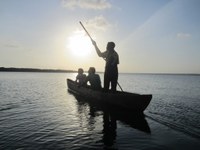Angola: Rehabilitating Angola's Protected Coastal Areas
Luanda — In an important move to promote sustainable development across its national territory, the Government of Angola will step up its efforts to protect a vast natural area along the Atlantic coast.
Under a new agreement, the country's Ministry of Environment will work with the Global Environment Facility (GEF), the European Union (EU) and the United Nations Development Programme (UNDP) to protect a 1.5 million hectare swathe of land known as Iona National Park, which forms part of a conservation area straddling the border with Namibia.
"This incredible biodiversity isn't just a beauty of nature, it sustains human life through ecosystem services such as agriculture, health, in addition to generating revenues from tourism. We absolutely must protect them," UNDP Resident Representative and UN Resident Coordinator, Maria do Valle Ribeiro, said.
 The area's unique ecosystems host populations of springbok, ostriches, oryx, zebras, and other wildlife, in addition to unique plants, including the Welwitschia, a species endemic to the Namibe region and a national symbol.
The area's unique ecosystems host populations of springbok, ostriches, oryx, zebras, and other wildlife, in addition to unique plants, including the Welwitschia, a species endemic to the Namibe region and a national symbol.
The project will aim to assess the size and dynamics of these plants and animals, as well as the threats they face.
Hunting is normally not practiced by the communities living within Iona National Park. However, poaching, fuelled by the illegal trade in bush meat, has become a major threat to the wildlife populations of the area and represents important potential losses in tourism revenue.
It is estimated that 15,000 people live in the Iona National Park, most of them nomads known as the Muhimba who derive their livelihoods from livestock.
Access to water is a huge concern and an important source of human-wildlife conflict. The Muhimba are known for maintaining their rich and unique cultural heritage in the face of sometimes strong external pressures.
"The project will reduce poverty and improve living conditions among the communities living on the perimeter of the project," the Ambassador of the EU, Javier Puvol.
Aiming to enforce anti-poaching efforts and reach out to populations in what is expected to become a model national park, the US$10 million project - formally launched at an event in Luanda earlier this year - will rehabilitate infrastructure, finance equipment and train rangers in anti-poaching techniques.
It will also involve local populations, developing with them community-based eco-tourism activities so they can generate additional income.
At the national level, the project will provide advice, staffing, training and technical support to the Ministry of Environment so it can design a national strategy for the management of protected areas in Angola.
An assessment of the current state of Angola's national parks is expected, with preparation of detailed plans for the rehabilitation of six protected areas.
Ecosystems and biodiversity provide the goods and services that help to sustain human life and wellbeing among local communities. Protecting them is key to ensuring Angola continues to further sustainable human development for all generations.



















